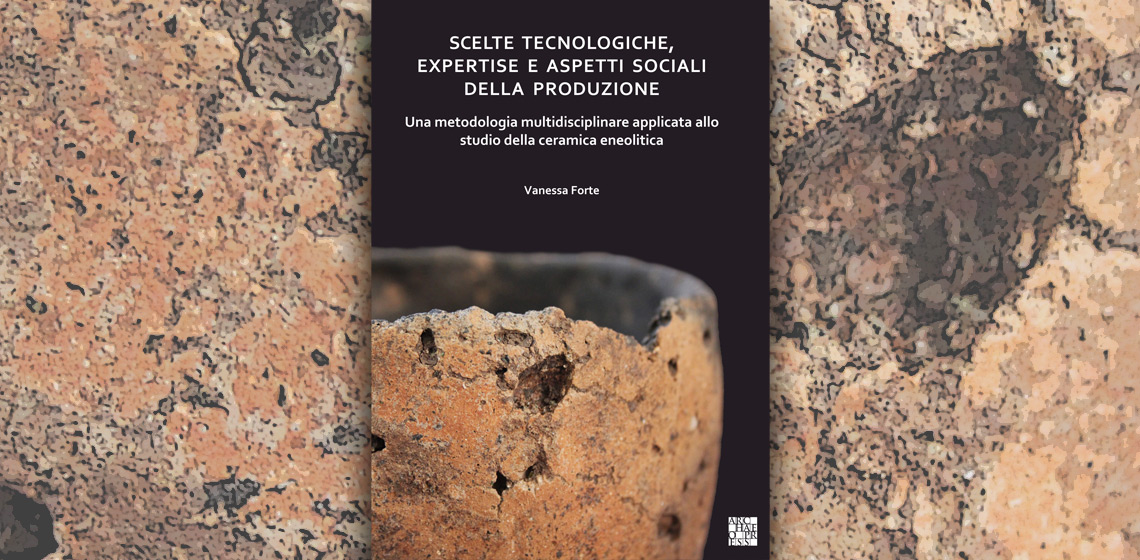
This book is a welcome addition to the bookshelf of Italian archaeologists interested in Prehistory and will certainly be of great use to those who are trying to gain a good understanding of pottery technology. Written in Italian, it is one of the few books in this language dealing with ceramic technology and the social aspects of the production by presenting, as a case study, the Copper Age domestic and funerary assemblages of the territory around Rome.
The author proposes a multidisciplinary methodology to the study of prehistoric pottery. Drawing from commonly used archaeometric approaches (ceramic petrography, XRF, XRD) and traceological analyses both on experimental and archaeological samples, Dr Forte reconstructs the sequence of craftspeoples’ gestures with the aim of inferring their technological knowledge and skill level. The methodological aspects of the research and the archaeological sites chosen as case studies are briefly discussed in the first two chapters.
The third chapter, written by the author and by Dr Laura Medeghini and Dr Michela Botticelli, deals with macroscopic paste analysis, the study of petrographic fabrics and firing temperatures. This is probably the most technical chapter of the book, and it might be a little complicated to understand at first for those who are not familiar with archaeometry, but it is fundamental in giving a brief overview of the pottery recipes in use in the area of Rome during the third and fourth millennium BC, as well as in providing information on the clay provenance and firing temperatures.
The experimental approach plays a great part in better understanding the expertise of prehistoric potters. The experimental framework, which is discussed in detail in the fourth chapter, was developed to cover all the steps of the chaîne opératoire of pottery production, taking into account different variables (type of paste, hygrometry, tools, gestures and so forth). This chapter is a good example of how experimental collections can help archaeologists not only in interpreting manufacturing traces by comparing archaeological traces with those on experimental samples, but also in verifying the potters’ skills and the time that was practically involved in the production process at different stages.
The fifth and sixth chapters reconstruct the technological choices of prehistoric potters as observable from the manufacturing traces on vessels from various domestic and funerary sites in the vicinity of Rome. The pottery assemblages are discussed in chronological order and the focus is particularly on domestic pottery given the great abundance and variety of pots from domestic environments (chapter 5) compared with pottery found in funerary contexts (chapter 6), which is usually less abundant and less fragmented, thus not always allowing macroscopic analysis of fractures or the use of destructive techniques such as petrography.
The last chapter is probably the most interesting as the author presents her conclusions on the social aspects of the production. Analysing the modes of production which are commonly applied by scholars to prehistoric pottery production, household production and household industry, Dr Forte introduces the concept of household specialisation. According to the author, this concept seems to better reflect some aspects of the Copper Age production, considering that certain vessels – some of those found in funerary contexts or related to feasting – entailed higher levels of expertise and required extensive training in pottery making. This training probably involved only a few individuals whose skill level was socially recognised within the community and who were capable of creating objects which could be perceived as “socially valued goods” (Spielmann 2002). Pottery making in Copper Age central Italy was thus an activity carried out on two distinct levels: one that required a basic level of expertise in forming, finishing and firing techniques, and one that was only accessible to those who had greater skill level (household specialisation).
Overall, I recommend this book to those archaeologists who are eager to learn in detail how prehistoric pottery was made in Italian Prehistory and to Italian scholars who might be willing to try new approaches to the study of pottery assemblages. The great amount of full-colour, high-resolution images of manufacturing traces, both on archaeological and experimental pottery samples, can also be a good reference for archaeologists who are just starting to work on archaeological pottery and need to familiarise themselves with these kinds of traces.
Last but not least, the book proposes a widely applicable terminology (in Italian) for the description of manufacturing traces visible in pottery shards. Hopefully in the future the issue of a widely agreed, consistent and mutually understood terminology to describe pottery manufacturing traces will be systematically addressed by scholars who are working on pottery technology in other European languages as well.
Book information:
Forte, V., 2020. Scelte tecnologiche, expertise e aspetti sociali della produzione. Una metodologia multidisciplinare applicata allo studio della ceramica eneolitica. Oxford: Archaeopress. ISBN: 978-1-78969-669-1

Bibliography
Spielmann, K., 2002. Feasting, craft specialization, and the ritual mode of production in small-scale societies. American Anthropologist, 104(1), pp.195–207.